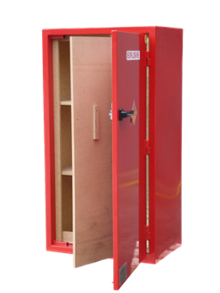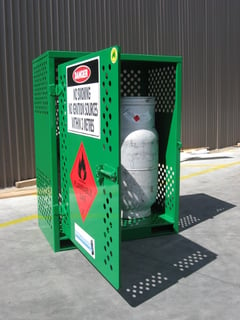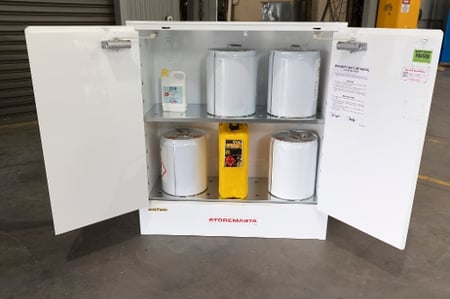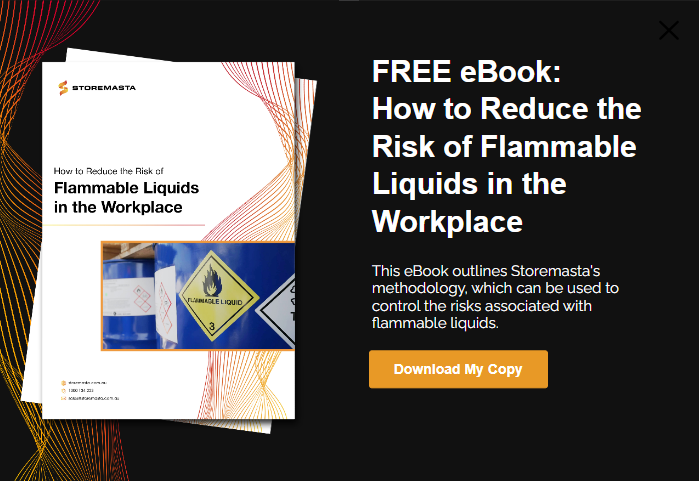No doubt you’ve heard of the term dangerous goods before, but do you understand what risks they pose to your organisation? This post will shed some light on the subject by looking at the various classes of dangerous goods and detailing the general risks associated with that article or substance.
The Classification of Dangerous Goods
Dangerous goods can be defined as an object, substance or material that presents a particular degree of risk to people, property and the environment due to its physical and chemical properties.
Dangerous goods are classified into nine core divisions as follows:
- Class 1: Explosives
- Class 2: Gases
- Class 3: Flammable liquids
- Class 4: Flammable solids; substances liable to spontaneous combustion; substances which, on contact with water, emit flammable gases
- Class 5: Oxidizing substances and organic peroxides
- Class 6: Toxic substances and infectious substances
- Class 7: Radioactive material
- Class 8: Corrosive substances
- Class 9: Miscellaneous dangerous substances
What are the Different Categories of Substances Classified as Risk?
The level of risk and type of reaction associated with dangerous and hazardous substances varies according to the class division and unique properties of the substance.
Naturally, the quantity, location and properties of other materials within the vicinity also play an important role in determining the level of risk associated with the substance in question.
In the next section of our post, we’ll be detailing some general risks associated with each class of dangerous goods. However, we recommend referring to the safety data sheet of each product, in addition to conducting a thorough onsite risk assessment before you start implementing controls to reduce the risks that your dangerous goods pose.
REMEMBER: Your material safety data sheets are essential documents which must be easily accessible, up to date and available to all staff and emergency services. Your safety data sheet will explain the properties of the dangerous goods that you’re carrying, as well as all hazards and control measures that are required.
Risks Associated with Dangerous Goods Class 1: Explosives
The risk and outcome associated with explosives is reasonably obvious.
Should an explosive contact with an ignition source, or a detonator with a booster, it will explode. Whether the key danger arises from the heat or the shock wave, the risk is very significant.
Class 1 dangerous goods must be handled and stored in a way that prevents the materials from igniting and exploding.
If any personnel are within the vicinity of the explosion, the likely consequences can include death, eruptions of ear drums and blood vessels, fire, inhalation of toxic gasses and severe burns.
Explosive substances also pose various risks upon property and the environment. This can occur on a large scale with explosive substances capable of causing major explosive incidents.
Risks Associated with Dangerous Goods Class 2: Gases
Gases are classed into 3 divisions:
- Division 2.1 gases are capable of ignition when a mixture of 13% or less by volume with air at standard lab conditions (20°C and 101.3kPa).
- Division 2.2 are non-flammable and non-toxic. However, they can act as an oxidizing agent.
- Division 2.3 have a toxic or corrosive nature.
As gas is often difficult to see (or smell), it can quickly spread throughout a workplace undetected. Depending on the gas’ dangerous goods division, the gas may also irritate the eyes and the respiratory system of staff who are in the vicinity of the accidental release.
Gases must be handled and stored in well ventilated areas as they pose a range of risks relevant to their dangerous goods division.
Risks Associated with Dangerous Goods Class 3: Flammable Liquids
Flammable and combustible liquids emit vapours capable of ignition when above their flash point temperatures. For flammable liquids, this is generally at or below standard working temperatures.
Should the vapour come into contact with an ignition source, the substance is likely to ignite, creating a very hot and fast burning fire. This blaze can damage people, property and the environment. There is also the added risk of toxic fumes harming staff and the surrounding community due to the ignition of flammable vapours.
Risks Associated with Dangerous Goods Class 4
These are thermally unstable dangerous goods, further classified into three divisions. Each division has different properties that vary the risks associated with the substances.
- Division 4.1 Flammable Solid: flammable solids are likely to self-react particularly through friction, generally in the form of a strong exothermic reaction.
- Division 4.2 Substances Liable To Spontaneous Combustion: substances spontaneously heat in normal conditions and likely to catch fire.
- Division 4.3 Substances Which, In Contact With Water, Emit Flammable Gases: substances will ignite in the presence of water, placarded as dangerous when wet.
Similar to Class 3 liquids, these goods are likely to combust in certain conditions. When they combust, the Class 4 solids release a toxic gas and can create a fast-moving fire.
IMPORTANT: Don’t forget to have emergency spill kits, working first aid kits and safety showers and eye wash stations in easy access in case an incident should occur. Refer to the safety data sheet, your risk assessment and the Australian Standards to determine the emergency decontamination equipment that you’ll require for your workplace.
Risks Associated with Dangerous Goods Class 5: Oxidizing Substances and Organic Peroxides
Chemically, oxidizing substances oxidize other materials, causing them to lose a number of electrons. This means that oxidising agents have the capability to react with other substances — causing them to spontaneously combust. The biggest risk that organic peroxides pose upon people is suffocation.
An organic peroxide is any organic compound. Organic compounds are compound that contains carbon. Organic peroxides are very unstable and susceptible to dangerous reactions such as combustion. These hazardous substances are also toxic and can cause serious irritation when brought into contact with eyes or skin.
Like to learn more about DG storage requirements?
Risks Associated with Dangerous Goods Class 6: Toxic Substances
The risk of toxic and infectious substances are described by the Australian Standard AS NZS 4452.
This Standard explains that toxic substances are liable either to cause death or serious injury or to harm human health if swallowed or inhaled by skin contact.
AS/NZS also define infectious substances as: "substances that are known or reasonably expected to contain pathogens, which can cause disease in humans or animals.”
Therefore, toxic substances, if not handled or stored correctly, can have negative impacts on humans, animals and the environment. Infectious substances can cause harm to humans and animals.
Toxic substances can harm human and animal health and must be contained and controlled in the workplace so such incidents don’t occur.
Risks Associated with Dangerous Goods Class 7: Radioactive Material
In our daily lives, we come into contact with Class 7 dangerous goods a lot more than most of us would realise.
A certain amount of radiation in our bodies is considered ‘normal’. However, should radioactive material be emitted in large quantities and escape into an uncontrolled environment, they can be very dangerous. As a result of the development of the atom bomb, the risks associated with radioactive materials are probably one of the most feared today.
Radiation is generally invisible, with waves of varying frequencies. Without going into too much detail, radiation ionizes parts of our cells and damages our DNA. Medically, one common result of radiation exposure is cancer.
Risks Associated with Dangerous Goods Class 8: Corrosive Substances
Have you ever seen the Class 8 black and white warning diamond sign — featuring a chemical substance burning a hand?
Corrosive materials eat away at a substance and gradually destroy them. As skin is a living tissue, the same principle applies. Corrosives can destroy most materials by erosion, but are also capable of burning the skin, respiratory tract, and eyes even to the point of blindness.
Corrosive subtances are also likely to share properties of other classes of dangerous goods, such as flammable liquids or toxic substances.
Risks Associated with Dangerous Goods Class 9 – Miscellaneous Dangerous Substances and Articles
Class 9 dangerous goods are substances that present a risk to people or property not covered by the other 8 classes. As there are a diverse range of articles and substances included in this class, there are no general risks that can be linked to the class overall.
However, there are some key articles and substances which we can discuss to understand the risks associated with these products.
Class 9 dangerous goods include items such as:
- Lithium-ion batteries – with Li-ion battery risks including thermal runaway, fire, explosion, emission of toxic gases
- Agricultural chemicals – possible risks including toxicity and environmental damage
- Solid carbon dioxide (dry ice) – hazards include human harm due to the carbon dioxide gas that is released if the dry ice melts
Understanding the Risks of Dangerous Goods
If your organisation uses dangerous goods on a regular basis, it’s very important that you store and manage them in a way that minimises the risks that they pose upon the people, property and environment of your organisation. This can be done by firstly identifying the dangerous goods classification of the substance. Once the DG classification and has been identified, along with the specific hazards, you can then start to implement controls in your workplace. If you would like more information on how to reduce the risks associated with flammable liquids, download our FREE eBook by clicking on the image below.

Living life by the 4 C’s of marketing – communication, coffee, compliance… and more coffee – Leisa Andersen is Storemasta’s Content Marketing Manager. When she’s not writing, you’ll find her enjoying all the good things in life, including shopping, travel and gluten free donuts.



